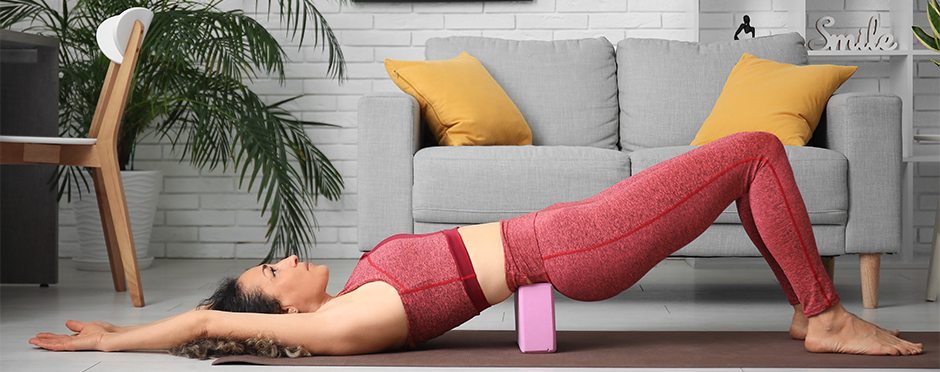
How To: Psoas Opener
Leave a CommentA key muscle that is often linked to low back pain is the psoas muscle. A great stretch to help alleviate tension and promote flexibility is a gentle psoas opener, which is a variation of the Bridge exercise commonly found in fitness routines.
To perform this stretch, you’ll need a yoga mat, a strap, and either a wool blanket or a yoga block. If you don’t have these specific items, feel free to improvise with what you have on hand, such as using a belt or a pillow in place of a strap or block. This stretch is gentle, making it suitable for most individuals, especially those experiencing low back pain. However, if you find that it aggravates your discomfort, please stop immediately. Let’s dive into how to perform the Psoas Opener!
- Start by sitting on your yoga mat. Take the strap and make a loop. The loop will be the same width as the yoga mat. The loop will go around the outside of both of your feet. Once the strap is around your feet, keep the feet the width of the mat so the tension stays on the strap. Then lower yourself down onto your back, keeping your knees bent.
- Here, you will need a folded wool blanket or a yoga block. Everyone is different in what they can tolerate during a stretch. Using the blanket is extremely gentle. Using the block will intensify the stretch a little more. So, if you know you have low back sensitivity, start with the blanket and progress to the block if it feels right. If you don’t have any low back sensitivity, you can use the block instead.
- From lying on your back, lift your hips to the ceiling, just like a bridge. Then place the blanket underneath your sacrum. The sacrum is right where the curve of your low back ends. If you are using the block, place it at its lowest height.
- From here, straighten your legs and keep the tension on the strap by pushing into it with your feet. Then take your arms up over your head towards the floor. You can grab your elbows here or keep them straight.
- Tip: Be mindful of where you place the block. You don’t want it too high, digging into the low back. And you don’t want it too low, digging into the lower half of the glutes and hamstrings, as shown in the photo below. It should feel comfortable and just right.
- Stay here for thirty seconds, up to a couple of minutes, depending on how you feel. If you aren’t feeling much of a stretch on the lowest block height, then you can lift your hips and turn it to the second tallest height to increase the stretch. Unless you are a practitioner of backbends, I do not recommend turning the block on its tallest side for safety reasons.
- To come out of the stretch, bend your knees, placing your feet on the floor, then lift your hips and remove the prop. Then let the low back rest on the floor for a few breaths to neutralize the back.
By nurturing your psoas muscle, you’re taking a vital step toward relieving tension and enhancing movement. If you experience pain or discomfort while trying it for yourself, please contact your nearest Athletico clinic to schedule a free assessment to talk with an expert who will assess your pain and provide next steps to help you feel your best.
*Per federal guidelines, beneficiaries of plans such as Medicare, Medicaid, Tricare, VHA and other federally funded plans are not eligible for free assessments.
*All exercises create some risk of injury or other adverse events. A physical therapist can personalize your exercise regimen and help mitigate some of these risks. Prior to starting a new exercise regimen consult a physical therapist or other qualified healthcare professional if you have ever experienced heart, circulatory problems, blood pressure, breathing, joint, or movement problems, decreased balance, feelings of dizziness, back pain, prolonged headaches or migraines, diabetes, or asthma, or if you are on prescription medications, recently completed a course of medications, recently had surgery, are pregnant or recently gave birth, or if your healthcare provider has advised against these types of exercise.
